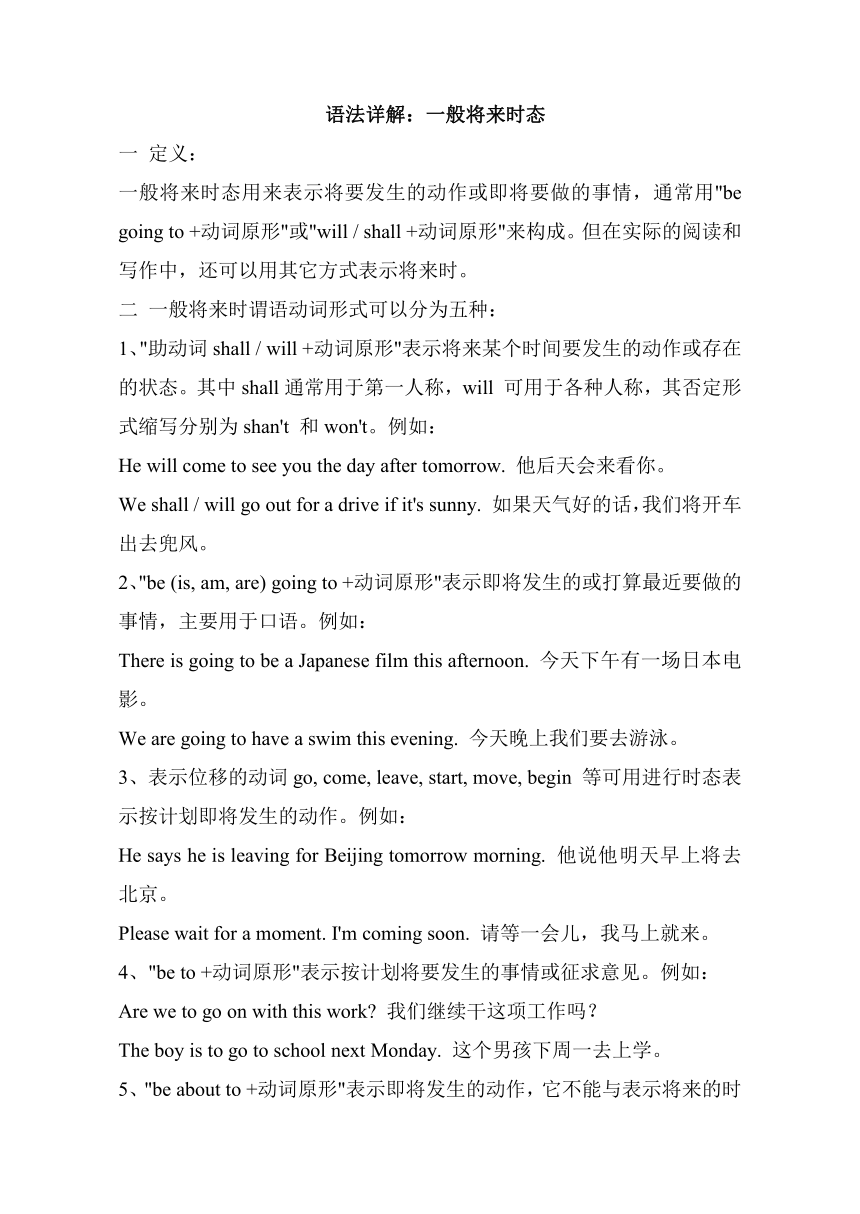Module4 语法详解:一般将来时态
图片预览

文档简介
语法详解:一般将来时态
一 定义:
一般将来时态用来表示将要发生的动作或即将要做的事情,通常用"be going to +动词原形"或"will / shall +动词原形"来构成。但在实际的阅读和写作中,还可以用其它方式表示将来时。
二 一般将来时谓语动词形式可以分为五种:
1、"助动词shall / will +动词原形"表示将来某个时间要发生的动作或存在的状态。其中shall通常用于第一人称,will 可用于各种人称,其否定形式缩写分别为shan't 和won't。例如:
He will come to see you the day after tomorrow. 他后天会来看你。
We shall / will go out for a drive if it's sunny. 如果天气好的话,我们将开车出去兜风。
2、"be (is, am, are) going to +动词原形"表示即将发生的或打算最近要做的事情,主要用于口语。例如:
There is going to be a Japanese film this afternoon. 今天下午有一场日本电影。
We are going to have a swim this evening. 今天晚上我们要去游泳。
3、表示位移的动词go, come, leave, start, move, begin 等可用进行时态表示按计划即将发生的动作。例如:
He says he is leaving for Beijing tomorrow morning. 他说他明天早上将去北京。
Please wait for a moment. I'm coming soon. 请等一会儿,我马上就来。
4、"be to +动词原形"表示按计划将要发生的事情或征求意见。例如:
Are we to go on with this work 我们继续干这项工作吗?
The boy is to go to school next Monday. 这个男孩下周一去上学。
5、"be about to +动词原形"表示即将发生的动作,它不能与表示将来的时间状语连用。例如:
He is about to move to Canada. 他将搬到加拿大去。
They are about to learn some new words. 他们将学一些新单词。
三 一般将来时常用的时间状语
这一时态常用的时间状语有:tomorrow, next time, in a month, from now on, later (on) , soon等。例如:
It's going to snow later (on). 过会儿要下雪。
Tom will come back in two days. 汤姆两天后回来。
I'll be more careful from now on. 从现在起我会更加小心的。
四 一般将来时的各种句式
一般疑问句:将句中的助动词shall/will 提前,或是在有be动词的情况下将be动词提前。例如:
Will you say more slowly,please 请再说得慢一些好吗?
Are you going to play computer games tomorrow afternoon 你打算明天下午玩电子游戏吗?
否定句,在will/shall,或是be动词之后加not,例如:
I won't be careless from now on. 从现在起我不会再粗心大意了。
There isn't going to be a film this afternoon. 今天下午没有电影。
PAGE
一 定义:
一般将来时态用来表示将要发生的动作或即将要做的事情,通常用"be going to +动词原形"或"will / shall +动词原形"来构成。但在实际的阅读和写作中,还可以用其它方式表示将来时。
二 一般将来时谓语动词形式可以分为五种:
1、"助动词shall / will +动词原形"表示将来某个时间要发生的动作或存在的状态。其中shall通常用于第一人称,will 可用于各种人称,其否定形式缩写分别为shan't 和won't。例如:
He will come to see you the day after tomorrow. 他后天会来看你。
We shall / will go out for a drive if it's sunny. 如果天气好的话,我们将开车出去兜风。
2、"be (is, am, are) going to +动词原形"表示即将发生的或打算最近要做的事情,主要用于口语。例如:
There is going to be a Japanese film this afternoon. 今天下午有一场日本电影。
We are going to have a swim this evening. 今天晚上我们要去游泳。
3、表示位移的动词go, come, leave, start, move, begin 等可用进行时态表示按计划即将发生的动作。例如:
He says he is leaving for Beijing tomorrow morning. 他说他明天早上将去北京。
Please wait for a moment. I'm coming soon. 请等一会儿,我马上就来。
4、"be to +动词原形"表示按计划将要发生的事情或征求意见。例如:
Are we to go on with this work 我们继续干这项工作吗?
The boy is to go to school next Monday. 这个男孩下周一去上学。
5、"be about to +动词原形"表示即将发生的动作,它不能与表示将来的时间状语连用。例如:
He is about to move to Canada. 他将搬到加拿大去。
They are about to learn some new words. 他们将学一些新单词。
三 一般将来时常用的时间状语
这一时态常用的时间状语有:tomorrow, next time, in a month, from now on, later (on) , soon等。例如:
It's going to snow later (on). 过会儿要下雪。
Tom will come back in two days. 汤姆两天后回来。
I'll be more careful from now on. 从现在起我会更加小心的。
四 一般将来时的各种句式
一般疑问句:将句中的助动词shall/will 提前,或是在有be动词的情况下将be动词提前。例如:
Will you say more slowly,please 请再说得慢一些好吗?
Are you going to play computer games tomorrow afternoon 你打算明天下午玩电子游戏吗?
否定句,在will/shall,或是be动词之后加not,例如:
I won't be careless from now on. 从现在起我不会再粗心大意了。
There isn't going to be a film this afternoon. 今天下午没有电影。
PAGE
同课章节目录
- Module 1 Lost and found
- Unit 1 Whose bag is this?
- Unit 2 Are they yours?
- Unit 3 Language in use
- Module 2 What can you do ?
- Unit 1 I can play the piano
- Unit 2 I can run really fast
- Unit 3 Language in use
- Module 3 Making plans
- Unit 1 What are you going to do at the weekends?
- Unit 2 We're going to cheer the players.
- Unit 3 Language in use
- Module 4 Life in the future
- Unit 1 Everyone will study at home
- Unit 2 Every family will have a small plane.
- Unit 3 Language in use
- Module 5 Shopping
- Unit 1 What can I do for you?
- Unit 2 You can buy everything on the Internet
- Unit 3 Language in use
- Module 6 Around town
- Unit 1 Could you tell me how to get to the Nationa
- Unit 2 The London Eye is on your right.
- Unit 3 Language in use
- Revision module A
- Module 7 My past life
- Unit 1 I was born in a small village.
- Unit 2 I was born in Quincy.
- Unit 3 Language in use
- Module 8 Story time
- Unit 1 Once upon a time….
- Unit 2 Goldilocks hurried out of the house.
- Unit 3 Language in use
- Module 9 Life history
- Unit 1 He left school and began work at the age of
- Unit 2 He decided to be an actor.
- Unit 3 Language in use
- Module 10 A holiday journey
- Unit 1 What did you do?
- Unit 2 This morning we took a walk.
- Unit 3 Language in use
- Module 11 Body language
- Unit 1 They touch noses!
- Unit 2 Here are some ways to welcome them.
- Unit 3 Language in use
- Module 12 Western music
- Unit 1 It's so beautiful!
- Unit 2 Vienna is the centre of European classical
- Unit 3 Language in use
- Revision module B
